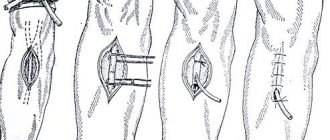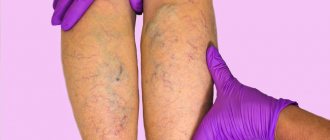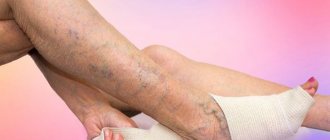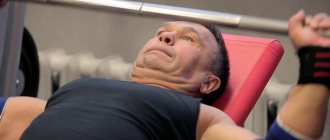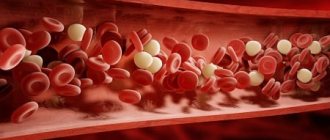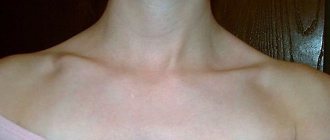What can be achieved during leg vein removal surgery?
Surgical intervention for varicose veins is aimed at solving the following problems:
- Elimination of reflux - pathological reflux of blood caused by incompetent venous valve.
- Removal of varicose veins. It is recommended if the vein has undergone a serious transformation and there is no hope of restoring normal blood flow in it. In this case, the section of the vessel that affected the varicose veins is removed, and the blood from it is redistributed to healthy veins.
- Combating cosmetic defects. Since CVI (chronic venous insufficiency) and the varicose veins caused by it do not change the appearance of the lower extremities in the best way, the operation should be aimed, among other things, at eliminating aesthetic defects.
Leg vein surgery
What could be the risk of injury?
Having deep cuts on the hand is quite dangerous, because when a hand is cut, there is a huge risk of damaging an artery, large vessel, or nerve. When there are deep cuts, if antiseptic treatment is not carried out in a timely manner, bacteria penetrate into the wound and it becomes a gateway for pathogenic microorganisms to enter the body.
During infection, hands with cuts become prone to gangrene or trophic non-healing ulcers. Such infections pose a threat to human life. When the inflammatory process begins, a deep cut may begin to fester, and there is a risk of phlegmon.
During this disease, purulent exudate does not appear on the surface of the skin. Remaining inside the human body and spreading throughout the surrounding tissues, it leads to intoxication. If you cut your hand, then if hyperemia and weakness occur, you must immediately call an ambulance, because such a condition is life-threatening.
Types of vein operations
The types of surgical interventions that modern angiosurgery can offer to combat varicose veins are divided into two groups:
- Operations aimed at mechanical resection of areas of veins affected by varicose veins with their subsequent ligation.
- Operations involving thermal or chemical effects on varicose veins.
The choice of the most appropriate leg vein surgery depends on the stage of development of the pathology, the age and general health of the patient, as well as the goals pursued during the procedure.
Ultrasound diagnostics of veins
Basic steps
- If the vessel is damaged on the leg, neck, or arm, it is important to press a bandage or cloth tightly to the damaged area of skin and hold it until the bleeding stops. Sometimes it even takes more than 15 minutes.
- In case of damage to a vessel on a limb, it is important to elevate it, this will speed up the coagulation process.
- Once the bleeding has stopped, bandage the damaged area tightly. Just make sure that the blood supply to the tissues does not stop. This is easy to check: press on the nail of the injured hand or foot; when it quickly turns pink, the bandage is normal.
Phlebectomy of the veins of the lower extremities: progress of the operation
Combined phlebectomy (venectomy) is the “gold standard” in the surgical practice of treating varicose veins.
!
This method is aimed at removing dilated varicose veins.
The operation has several varieties, each of which is named after its inventor: phlebectomy according to Babcock, according to Narath, according to Müller, according to Troyanov-Trendelenburg, which are performed under local (in case of extensive vascular damage - under general) anesthesia.
Despite the differences, all these operations to remove veins on the legs have a common feature: they involve making incisions or punctures on the skin ranging from 1 mm to 5-6 cm in length, through which the angiosurgeon, using special hooks, pulls the affected vein to the surface. The veins are excised, ligated and removed, after which sutures or a special patch are applied to the skin. This operation to remove varicose veins on the legs is highly effective and allows you to achieve positive results in the treatment of venous pathology.
Phlebectomy of leg veins
Providing first aid for a cut
Anyone can provide first aid for a minor cut independently at home. A cut wound requires compliance with a strict algorithm of actions, which is as follows:
We recommend reading: First aid for bleeding
- Assessment of the severity and nature of damage.
- It is necessary to rinse the wound surface under running water.
- Limit contact of the wound surface with foreign objects to prevent infection.
- Apply a pressure bandage made of a sterile bandage to the cut area or apply digital bleeding control. With superficial damage, the blood clots within 4–5 minutes.
- If a vein is cut, a tourniquet should be applied below the damaged area and the victim should be hospitalized in the future.
- After the hemorrhage has stopped, the cut site should be disinfected with hydrogen peroxide, however, in case of deep damage, the solution must be prevented from getting into the wound.
- The edges of the wound surface are treated with an alcohol solution of brilliant green or iodine.
- Apply a sterile gauze bandage to the wound, which must be constantly moistened with alcohol solutions to avoid sticking to tissues.
Applying a pressure bandage
If there is no positive effect within 10–15 minutes after providing first aid, you must call an ambulance.
Vein surgery with laser
As medicine developed, more modern and less traumatic methods of performing vein removal operations began to appear in the arsenal of vascular surgeons compared to classical surgery. With their help, it is possible to reduce the time of the procedure, minimize postoperative scars, and also reduce the likelihood of complications and side effects. One of these methods is laser surgery on the veins of the lower extremities (endovenous, endovasal or endovascular laser coagulation).
A special laser light guide is inserted into the cavity of the affected vessel, heating the blood and vein walls. Under the influence of high temperatures up to 120 degrees, the walls of the vessel stick together, as a result of which blood stops flowing into this part of the circulatory system.
Expert opinion
Depending on the area of the lesion and the number of veins to be removed, treating varicose veins in this way usually requires several procedures lasting 30-60 minutes.
Vascular surgeon, phlebologist
Osipova Ekaterina Yakovlevna
The operation to remove veins with a laser is low-traumatic, gives a good cosmetic effect (after it there are no noticeable scars left on the skin), and does not require long-term hospitalization. However, it must be taken into account that this technique is not suitable for treatment in the later stages of varicose veins, when the diameter of the veins is significantly increased and there are varices; traditional surgical intervention will be required to eliminate them.
Legs after vein surgery
Ways to stop bleeding from a vein
In medicine, a distinction is made between temporary and permanent stopping of blood loss; tourniquets, bandages, cauterization and ligation of blood vessels are used for these purposes. Temporary methods can be used independently or with outside help, and the final method is used exclusively in a hospital setting.
What to do if you need to provide first aid yourself:
- Finger pressure of the vessel. The method is used for superficial injuries, when there is a possibility of pressing the vein against the bone. The thumb must be pressed against the cut vessel, applying significant pressure. The duration of pressure is short-term until another method is used.
- Pressure bandage. Several bandages are applied to the damaged area, then a layer of cotton wool is applied, then a whole bandage is applied again, after which the structure is secured by applying a tight gauze bandage. After the manipulation, it is necessary to check the pulse; its absence indicates that the bandage was applied incorrectly.
- Full flexion of the limb. Serves as an additional method when flexion of the limb leads to compression of the vessel, resulting in reduced blood loss. After bending, the limb should be fixed.
How to stop bleeding using definitive methods:
- Cauterization. A vessel of small diameter can be cauterized. High temperatures destroy the vascular walls, forming a blood clot that clogs it. For this purpose, an electrocoagulator and a laser using silver nitrate are used.
- Stitching. Damaged soft tissues are sutured together, the suture material helps to compress the lumen, which reduces the volume of blood flowing out.
- Vessel ligation. Cuts to large veins cause massive bleeding, which is stopped by direct ligation of the vessel with further plastic surgery. During the procedure, both ends of the vein are clamped, then several turns of suture material are made. If the main vessels are damaged, the technique is not used, since blood circulation is disrupted. In this case, stitching of the injured parts is used, forming an anastomosis.
Cuts in the vein area are quite dangerous types of injuries, as there is a risk of heavy blood loss, which can be fatal. Of particular danger are suicidal cases when damage to the large veins of the forearm occurs. As a rule, when an injury occurs, cuts are observed in the nerve fibers and tendons, which impairs the functional ability of the limb. These situations require immediate contact with specialists who, after assessing the severity, will be able to provide full assistance.
Sclerosis
This is another modern vein removal operation that allows you to achieve noticeable results with minimal trauma. A sclerosant, a special liquid or foamy substance that glues the walls of the affected area of the vein, is injected into the lumen of the dilated vessel. A course of sclerotherapy allows you to achieve a quick cosmetic effect without scarring, which makes it very popular. However, this procedure is only suitable for the initial stage of varicose veins, as well as telangiectasias.
Sclerosis of the veins of the lower extremities
Types of sclerotherapy
According to the form of the drug:
- foam: is today the preferred method of treating varicose veins. This is a liquid form of the drug mixed with air;
- liquid (traditional): rarely used nowadays.
According to the execution method:
- conventional: when administering sclerosant, ultrasound control is not used;
- with ultrasound control: provides monitoring of the movement of the drug and the filling of all areas of the varicose vein that are invisible to the eye.
Advantages of using foam sclerosant
- Due to the absence (displacement) of blood in the lumen of the vessel, more complete contact of the drug with the vein wall occurs
- Due to gas bubbles, the required dose of medication is reduced
- Longer contact of the foam with the vein wall and an increase in the extent of the sclerosed zone
- Possibility of ultrasound monitoring of drug administration and its progress through the veins
The number of sessions is determined by the doctor
Preparation for vein surgery
Before surgery, it is necessary to carry out preparatory measures: ultrasound of the veins of the lower extremities, clinical blood test and coagulogram. On the eve of the procedure, you need to shave your leg without using creams, gels or other cosmetics.
Expert opinion
If general anesthesia is planned, you should abstain from food 8 hours before the procedure (although in some cases the doctor may allow a light snack). A cleansing enema may also be required before general anesthesia.
Vascular surgeon, phlebologist
Osipova Ekaterina Yakovlevna
Examination of leg veins before surgery
Consequences
- Cuts on the hands (photo above) can result in irreversible consequences if they are inflicted on the wrist area. In this case, the nerves and tendons are damaged.
- Often during an injury, the victim receives a deep cut to the arm. What to do? Contact your doctor immediately. The fact is that treatment of deep wounds is carried out by applying sutures immediately after the injury. If this is not done eight hours after the cut, the wound cannot be sutured at all in the future, as bacteria will have time to get into it. When the wound is closed, they can cause suppuration.
- If cuts on the hands are accompanied by heavy bleeding with bright scarlet blood, then the artery is damaged.
- Remember, even a minor cut, especially on the face, leaves a scar.
- If the foreign body fragments are not removed from the wound, it will become inflamed and pus may ooze from it.
- To prevent a serious cut injury from causing complications, you should be vaccinated against tetanus.
Cuts on the hands, even if they are well treated, can lead to several consequences:
- If you cut your hand in the area of the wrist joint, this leads to disruption of the integrity of the nerves and tendons;
- If you do not stitch the edges of the wound within eight hours after receiving the injury, then it will no longer be possible to sew it up at all due to the microorganisms that have gotten inside, and an unsutured wound will be much more difficult to heal;
- If the artery is damaged, as evidenced by the bright scarlet color of the blood, severe bleeding is possible, leading to death without assistance;
- The wound surface may become suppurated if the glass fragment is not removed from the wound in a timely manner;
- Even a small abrasion can leave a scar, let alone deep cuts.
Recovery after vein surgery
The duration of the recovery period depends on the number of veins removed, the general health of the patient, and his compliance with the phlebologist’s recommendations.
!
Typically, the recovery period lasts from 2 months to six months.
Depending on the type of surgery, the patient may be advised to limit activity during recovery. For example, after laser coagulation and sclerotherapy, you can get up and move immediately; after sclerotherapy, you must walk for about an hour, while combined phlebectomy requires a certain period of limited mobility.
Leg recovery after vein removal surgery
What to do next
Light, small cuts on the wrists do not require any special treatment. It is enough to regularly treat them with antiseptics, for example, brilliant green, change the patch and bandages.
Strong, deep cuts on a guy’s or girl’s wrists take a longer period of time to heal; you won’t be able to quickly get rid of wounds and marks. It can be accelerated if, in addition to antiseptic solutions for rinsing and disinfection, special ointments are used. What drugs should I pay attention to? Healing is promoted by:
- Solcoseryl. An ointment based on calf plasma extract helps to quickly heal deep cuts without consequences. A thin protective film forms on the surface of the wounds, blocking the path of pathogenic microorganisms from the outside. And under the film there will be an active process of wound healing and tissue restoration thanks to the active components in the product that stimulate metabolic processes. The ointment has contraindications, so you must read the instructions carefully before use.
- Vishnevsky ointment. It does not directly promote tissue restoration, it acts more like an antiseptic, but this is also very important in the healing process. The wounds will not fester and become inflamed, and will heal faster.
- Rescuer. Helps well with shallow cuts and abrasions. It also protects against infection in open wounds and inflammation, accelerates metabolic processes and thereby stimulates the rapid healing of skin damage.
Any of the listed products is applied in a fairly thick layer to the damaged areas of the skin, and a bandage is applied on top. It needs to be changed at least 2 times a day. Cuts heal from 2 days to 2-3 weeks.
Recommendations for rehabilitation after leg vein removal surgery
To reduce the risk of relapses and complications after surgery, there are some restrictions and recommendations that should be followed:
- You need to wear jersey with a suitable level of compression. Tights or stockings after vein surgery are a prerequisite for normal restoration of blood flow in the lower extremities.
- Adjust the load on your legs. Here it is important to choose the “golden mean”: to avoid complete immobility and prolonged standing, sitting, or running.
- Do not lift heavy objects (during the recovery period, the maximum permitted weight is up to 5 kg).
- Do not take a hot bath, do not steam in a bathhouse or sauna, and avoid exposing the skin in the area of remote veins to direct sunlight for some time.
Recommendations after vein removal surgery: do not take a hot bath.
- Wear loose trousers or skirts, avoid narrow, uncomfortable shoes (especially heels).
- Take medications prescribed by your doctor. Most often, venotonics, anticoagulants, and antioxidants are prescribed.
Signs of venous bleeding
Bleeding from a cut in a large-diameter vein poses a threat to the patient's life, since there is a possible risk of air embolism. To provide adequate assistance, it is necessary to correctly determine the nature of the damaged vessel. So, venous bleeding can be determined by the following signs:
- Presence of damage in the area of the vein.
- When a vein is cut, the blood is dark red in color.
- The blood flows out in a smooth stream without pulsation.
- Pressing on the area above the injury reduces the rate of blood loss.
- Reduced blood pressure levels.
- Cardiopalmus.
- Weak pulsation in the main arteries.
- The skin becomes pale.
- Temporary loss of consciousness.
Arterial hypertension and diseases of the coagulation system lead to increased venous bleeding
When a superficial vein of the upper or lower limb is cut, blood flows out with low intensity, so the bleeding can self-limit. In such cases, first aid should also be provided, as there is a possible risk of damage to deeper vessels.
how to sew up veins
Hello girls! I went to the pathology department of the first maternity hospital on July 7th, it’s good that it was on time…. Nothing foreshadowed such an outcome... We did a CTG, but the doctor did not like the result. They did it again... Bad again. They took me down to the maternity ward so that I could lie quietly there longer while the CTG was being written. The doctors came. They saw my swelling, which was becoming stronger and stronger every hour... They consulted and said that I urgently needed to have a caesarean section, to become a mother. B was 38 and 4. Out of nervousness and surprise, I started to go hysterical... Tears were flowing and there was no way to stop them. The face was swollen... And then the trash started! They began to look for a vein to take blood and install a catheter. The nurse refused after the fifth attempt. An anesthesiologist was called. An hour of torment, all hands are beaten, the result is zero. But you have to hurry, the child has a very low heart rate. Critically low! It was decided to place a catheter in the neck, use an ultrasound to find a vein and, following the needle on the monitor, the doctor would finally achieve a result. They took me to the birth room. On the operating table. In short, the idea with a vein in the neck also failed at first. It hit, but not in a vein, but in an artery. Pulled it out. 2 brigades of people gathered! Finally, after long and persistent torment, the vein was found! The catheter is installed. For reliability, they also decided to sew it to the skin of the throat. We made two stitches. Then a catheter into the bladder, well, all girls are familiar with this... And then spinal anesthesia. Even though they didn’t torture me here, it had an immediate effect. My legs were numb. Belly too. Installed the screen. Go! The sensations, so to speak, are not pleasant, but not painful. It’s as if you’re being torn in half from the inside... At the most unpleasant moment, the doctor told me that this second I’m giving birth! And then I heard my girl scream! And then she meowed, honestly, the sound was like a kitten meowing! And then she sneezed!
